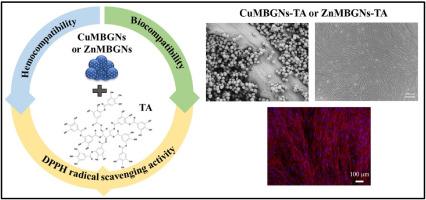单宁酸负载锌和铜掺杂的介孔生物活性玻璃纳米颗粒:伤口愈合的潜在抗氧化纳米载体
IF 18
1区 医学
Q1 ENGINEERING, BIOMEDICAL
引用次数: 0
摘要
多酚类物质如单宁酸(TA)具有抗菌和抗氧化活性,近年来在伤口愈合方面的应用引起了人们的极大关注。介孔生物活性玻璃纳米颗粒(MBGNs)作为治疗性生物分子的纳米载体也引起了相当大的兴趣。本研究主要研究了掺杂两种众所周知的生物活性元素铜(Cu)和锌(Zn)的ta负载MBGNs的制备。在潜在伤口愈合应用的背景下,研究了TA负载对纳米颗粒抗氧化和生物特性的影响。经过各种技术的验证,TA已成功加载到CuMBGNs和ZnMBGNs上。随着TA浓度的增加,纳米颗粒中的酚类物质含量增加,cummbgns -TA和ZnMBGNs-TA具有清除1,1-二苯基-2-苦酰肼(DPPH)自由基的活性。纳米颗粒不仅对正常人真皮成纤维细胞(NHDF)具有生物相容性,而且还具有血液相容性。与cummbgns - ta渗滤液相比,体外伤口愈合率为66% - 83%,ZnMBGNs-TA溶出产物的伤口愈合率更高(> 90%)。我们的研究结果表明,CuMBGNs或ZnMBGNs是抗氧化TA的合适纳米载体,是促进伤口愈合的候选材料。本文章由计算机程序翻译,如有差异,请以英文原文为准。

Tannic acid-loaded zinc- and copper-doped mesoporous bioactive glass nanoparticles: Potential antioxidant nanocarriers for wound healing
Polyphenols such as tannic acid (TA) with antibacterial and antioxidant activities have recently attracted significant attention for wound healing applications. Mesoporous bioactive glass nanoparticles (MBGNs) have also garnered considerable interest to be employed as nanocarriers of therapeutic biomolecules. This study focuses on the fabrication of TA-loaded MBGNs which were doped with two well-known biologically active elements, copper (Cu) and zinc (Zn). The effect of TA loading on the antioxidant and biological properties of the nanoparticles was investigated in the context of potential wound healing applications. As proven with various techniques, TA was successfully loaded on CuMBGNs and ZnMBGNs. With increasing TA concentration, the phenolic content in the nanoparticles was found to increase and CuMBGNs-TA and ZnMBGNs-TA were found to possess 1,1-diphenyl-2-picrylhydrazyl (DPPH) radical scavenging activity. The nanoparticles not only showed biocompatibility towards normal human dermal fibroblast (NHDF) cells, but they were also found to be hemocompatible. In comparison to CuMBGNs-TA leachates resulting in in vitro wound closure rate of ∼66 %–∼83 %, the dissolution products of ZnMBGNs-TA led to higher wound closure rate (>90 %). Our results demonstrate that CuMBGNs or ZnMBGNs are suitable nanocarriers for antioxidant TA and are candidates to promote wound healing.
求助全文
通过发布文献求助,成功后即可免费获取论文全文。
去求助
来源期刊

Bioactive Materials
Biochemistry, Genetics and Molecular Biology-Biotechnology
CiteScore
28.00
自引率
6.30%
发文量
436
审稿时长
20 days
期刊介绍:
Bioactive Materials is a peer-reviewed research publication that focuses on advancements in bioactive materials. The journal accepts research papers, reviews, and rapid communications in the field of next-generation biomaterials that interact with cells, tissues, and organs in various living organisms.
The primary goal of Bioactive Materials is to promote the science and engineering of biomaterials that exhibit adaptiveness to the biological environment. These materials are specifically designed to stimulate or direct appropriate cell and tissue responses or regulate interactions with microorganisms.
The journal covers a wide range of bioactive materials, including those that are engineered or designed in terms of their physical form (e.g. particulate, fiber), topology (e.g. porosity, surface roughness), or dimensions (ranging from macro to nano-scales). Contributions are sought from the following categories of bioactive materials:
Bioactive metals and alloys
Bioactive inorganics: ceramics, glasses, and carbon-based materials
Bioactive polymers and gels
Bioactive materials derived from natural sources
Bioactive composites
These materials find applications in human and veterinary medicine, such as implants, tissue engineering scaffolds, cell/drug/gene carriers, as well as imaging and sensing devices.
 求助内容:
求助内容: 应助结果提醒方式:
应助结果提醒方式:


